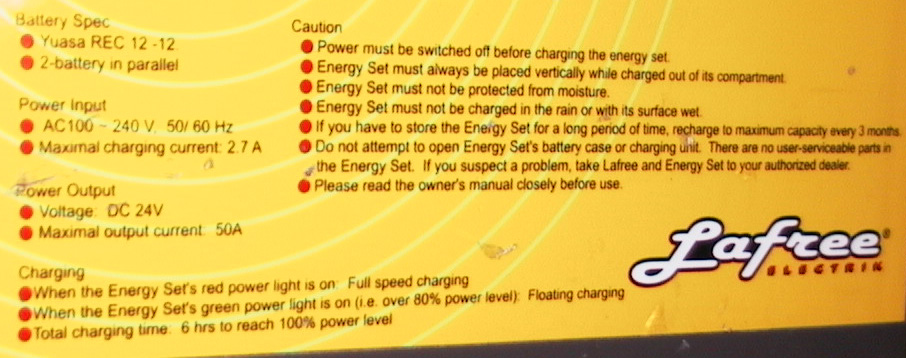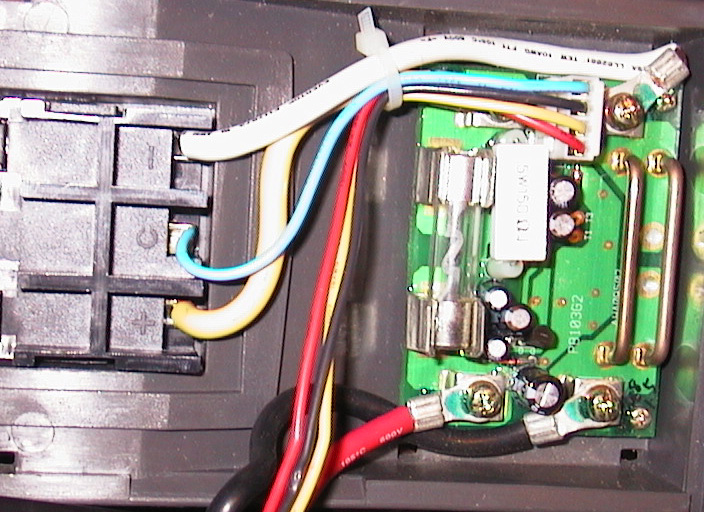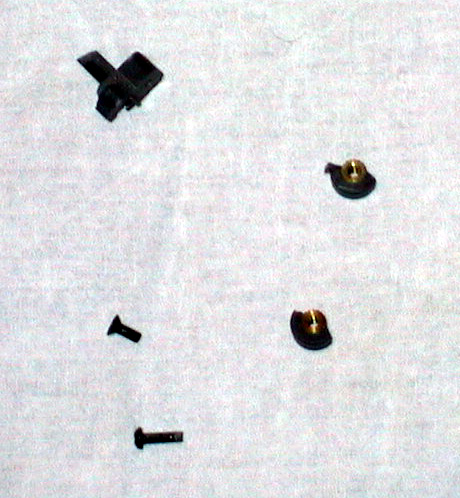The Battery
Overview
Itís heavy (25 lbs) and cumbersome to remove from and insert into the bike Ė I just leave it there and run an extension cord to the charge cord. Itís a 24V, 12AH battery pack. Thatís 288 Watt Hours of energy total Ė enough to sustain 1/3 HP for an hour in a 100% efficient system. Itís a sealed lead acid battery.
Charging
There are two types of energy pack for the LaFree Ė one with a built-in charger and one with an external charger. The external charger weighs 3 pounds. The energy pack with internal charger weighs about 2-3 pounds more than the energy pack without the charger. They both function as smart chargers Ė they charge the battery from dead to 80% capacity in 4 hrs, then switch to trickle charge mode for the 81-100% charge, which takes another hour or so. After that, the charger will maintain peak charge on the battery. As a result, you can leave the charger on all night long without fear of overcharging the battery and have a freshly charged pack in the morning.
Charge the battery when itís at room temperature. If itís cooler or warmer when being charged, it wonít have as much capacity as it will at room temperature (70 degrees F). Do NOT charge the battery if itís warmer than 110 degrees F or cooler than 32 degrees F. Iíve also heard that itís a bad idea to let the battery freeze, so I take it inside when itís below freezing.
Note about battery models with external chargers:
The external charger and battery combination also counts the number of charge cycles since the last refresh cycle (full discharge and recharge done by the charger) and automatically begins a refresh cycle. For the 20th-29th charge cycle, this can be overriden by pushing the red button in the first 10 seconds of the refresh cycle. When the 30th charge cycle is reached, a refresh cycle is forced. When the refresh cycle is completed, the count is reset to 0.
Note: As an electrical engineer, I really don't know what the hell this is all about. The manual says that this is necessary to extend the life of the battery, and that it completely discharges the battery during the refresh cycle. This "refresh" might be necessary for NiCad batteries, but the LaFree bikes contain Sealed Lead Acid batteries, and it's generally considered to be detrimental to discharge this type of batteries below 50% charge level. I have noticed that the charge level lights don't work very well when the battery is at the end of its life. Perhaps this is a way the bike calibrates the charge LEDs?
Technical Info about the battery
Each sealed lead acid battery size:
3.85" Long (2 together)
3.9" high (including terminals)
5.9" Wide

The battery, removed from the plastic housing
Taped together battery size:
7.7" Long
3.9" High
5.9" Wide

Text from the side of the energy cell
Battery Specs:
ďYuasa Rec 12-12 12V 12AhĒ
2 Battery in Parallel spec on the side of the battery case is clearly wrong. They're in Series.
These can be purchased for $50 per set of two.
Battery box dimensions (space for aftermarket batteries):
6.0" Front to back (when in bike). 7.9" tall. 4.0" wide.

Battery Fuse Board
Fuse (Battery):
60A (No Voltage rating, use one from Car Stereo Shop),
1.375" long x 3/8" diameter
Charger Info:

On charger Board: "CAUTIUN: FOR CONTUNUED PROTECTION AGAINST RISK OF FIRE REPLACE ONLY WITH SAME TYPE AND RATING OF FUSE."
Fuse (Charger)
3A 250V
3/4" long x 3/16" diameter
Red/Yellow/Black Wires coming from charger (as labelled on batt fuse board):
Red: +24VDC
Black: Common/Ground/0VDC
Yellow: Charging Done Ė switch to trickle charge.
Speculation: The charger module itself isn't smart - it just has an input that tells it when to switch to slow charge. There are electronics in the energy cell that determine when the battery is at peak charge and switch the charger from fast charge to trickle charge mode.
Battery Pack Outputs: +, -, and C
+: Fused +24V high current output. Large (yellow) wire tied to one side of fuse. Other side tied to (+) side of one battery through red wire.
-: Ground. Tied to (-) terminal of one battery. Large (white) wire connected to battery fuse board. Shunts on that board connect to the (-) side of one battery.
C: This is a small diameter blue wire connecting to the battery fuse board. I guess that it provides battery charge level info to the bike and the charger. It is not common, ground, neutral or a center tap between the two batteries. Measures OV DC and AC to ground and +24V when out of the bike. It could also be used for diagnostics purposes Ė for instance to communicate to the controller module that the onboard fuse has blown.
Symptoms of dead batteries in the energy cell
I was riding along, minding my own business, with four of the five battery level LEDís lit, when it happened: A loud beep and the motor shut off. I checked again and only one light was lit. I didnít think that was right, so I rebooted the bike (shut it off and turned it on again), and again I had four lights and the bike worked again. I figured that I needed to tighten the battery connectors and went on my way. 5 minutes later, it happened again. This time when I restarted, it didnít have much power.
In hindsight, I should have known. The battery charged in about 1.5 hours instead of the 4-5 listed in the manual. I figured that I wasnít using all the energy and thatís all it needed to replenish what I removed during my ride to work. I bought the bike well-used, and should have expected to replace the battery. I thought if it went at all, it was good. Not the case.
Notes on
the battery:
Drawing less than 20% of total energy in pack between charges extends life of battery pack indefinitely. Recharge after every run and every 3 months if storing for extended periods.
When drawing 80% of the total energy in the pack between charges, the battery life will be about 1-1.5 years.
The battery life (the number of charge cycles, not the run time per cycle) might be able to be extended to 2.5 times its current value by adding a couple of capacitors (in parallel to the battery) that would provide for the instantaneous current demands of the motor. See this article for more info. The article mentions Ultracapacitors, but in the case of an E-bike, I think this might work with a couple of large (1F) 12V caps like the ones used in the car stereo industry.
http://www.evworld.com/databases/storybuilder.cfm?storyid=178&first=11222&end=11221
The energy cell has a problem: When dropped, metal fasteners can break loose from the inside and cause electrical shorts. If your battery rattles, I recommend that you take it apart and find out why, even if it still works. Here are a few of the things that were rattling around inside my battery:

This is stuff that I found rolling around in the battery
The good news is that the energy cell is designed in such a way that all the plastic panels interlock and lock onto the charger, and it will stay together even without any of the screws holding it together!